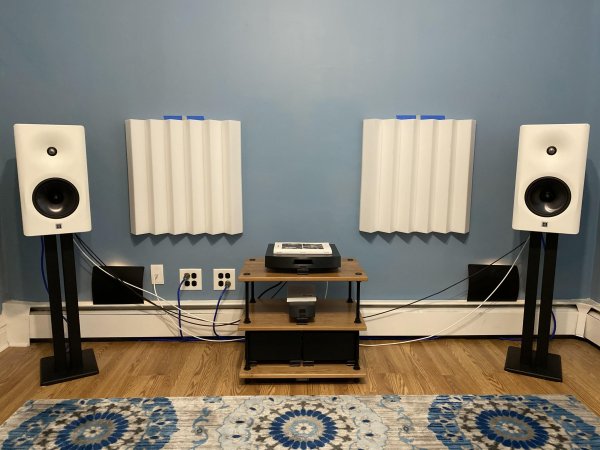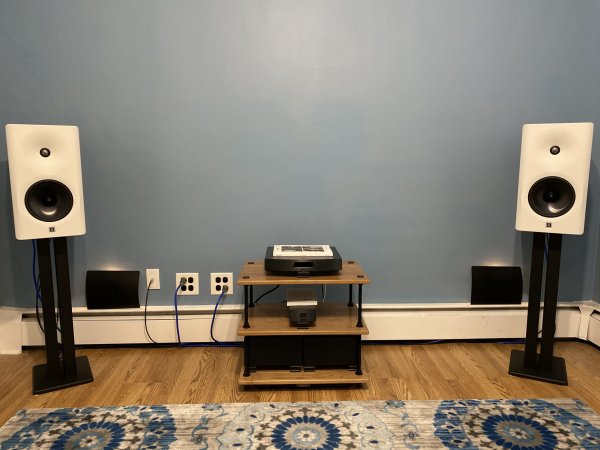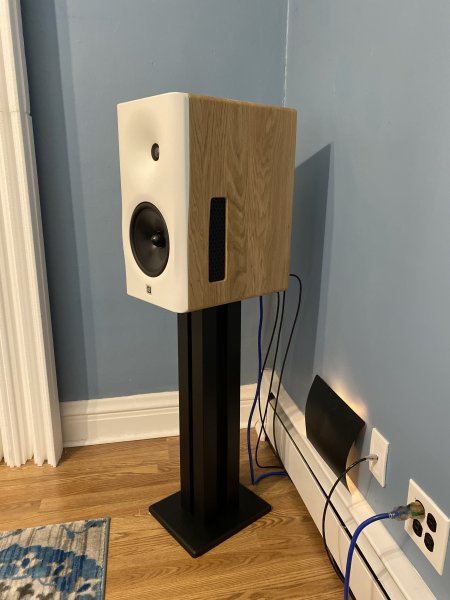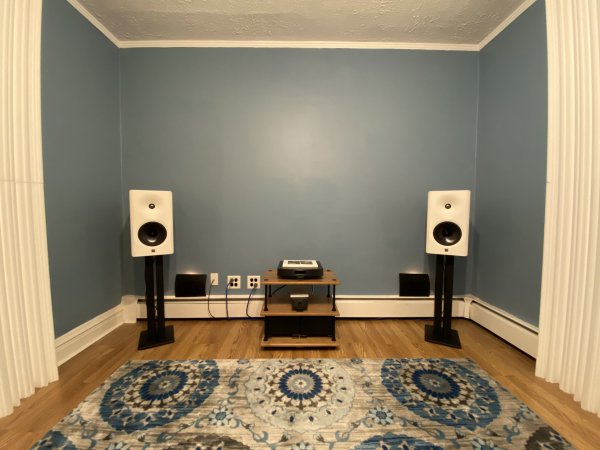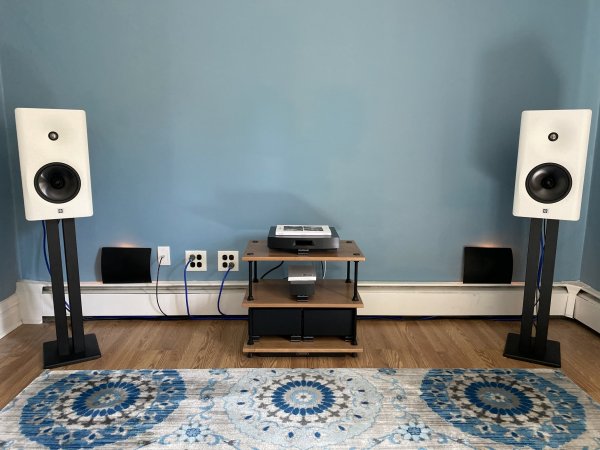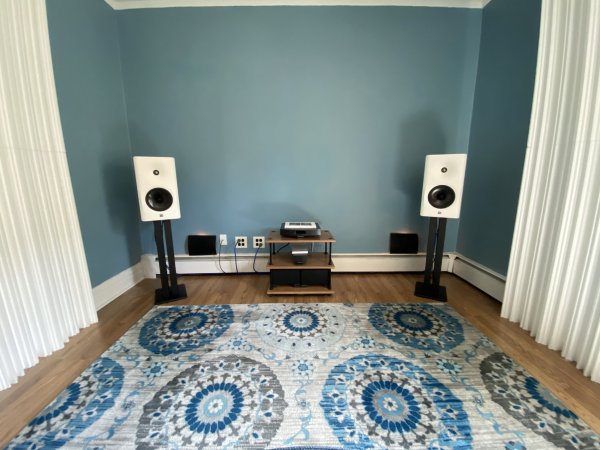Given the wide range of "walk on water" reviews and comments, I just had to get a pair of Dutch & Dutch 8c speakers to further simplify my system. I suggest reading the review by Mitch Barnett (mitchco) first--it's the most thorough and rigorous by far, I think. But there are reviews in Stereophile, 6 Moons, Soundstage, Darko (the only reviewer who had a lot of problems getting them to work), Sound on Sound, NextWeb, Hi Fi Knights, HiFi+, Streaky, and Erin's Audio Corner, to name a few others. The 8c is the current darling of sound engineers and there are a number of very long threads discussing it on pro-audio forums like Gearslutz.
If these work out, it would be another step and perhaps ultimately the final step in simplifying my system. They are internally triamped and have integral subs, a DAC, crossovers, parametric EQ and room optimization, network connections, and eventually they will be a Roon endpoint. Right now, I can feed them either balanced analog or AES digital signals from my Lumin X1 streamer. I would eliminate the Benchmark Amps and speaker cables.
Once the Roon endpoint bugs are worked out (soon, they keep saying), even my streamer and the cables from the streamer to the speakers could go. At that point, the equipment rack could also go since I would no longer need the Lumin Streamer. The system would consist of the speakers, their associated cabling (power and ethernet), my P.I. Audio Group UberBusses, the P.I. Audio Group AQD sound diffusors room treatment, and my iPad Pro to control everything.
I ordered the speakers from Vintage King Audio, one of the USA dealers, and worked with David Fisk, one of their sales people. I happened to order them at just the right time when a couple of pairs were making the voyage by ship across the Atlantic from the Netherlands to Dutch & Dutch's USA distributor in Florida. Thus, I only had to wait about three weeks for delivery. They got here around dinner time. I expected them much earlier in the day so before they arrived I busied myself that day disassembling the system and reconfiguring it for the new speakers.
I no longer need my pair of Benchmark AHB2 amps since the D&Ds are self-powered. I also decided to go back to my old blue Absolute Power Cord Mk IIs (a Ching Cheng-manufactured power cord marketed many years ago by GTT Audio), putting them in place of the relatively unwieldy Triode Wire Labs cords. Only five power cords are needed now: one for each P. I. Audio Group UberBuss, one for the Lumin X1 streamer, and one each for the speakers. I added a TP Link ethernet switch to accommodate running three ethernet lines now: one for the Lumin and one to each speaker. That ethernet switch is powered by a 5-volt iFi aftermarket wall-wart power supply also plugged into one of my UberBusses.
I moved the two UberBusses to the bottom shelf of my three-shelf Salamander Archetype rack, where the amps were previously. That freed up the floor space for putting the new speakers close to the wall behind them, as they are designed to be. I moved the new speakers further apart so that they are 85" tweeter to tweeter when toed in to point at my ears. I still had to move my listening position forward more than 16" to maintain an equilateral triangle, so my ears are now about 93.5" from the wall behind the speakers. The backs of the speakers are 8" from the wall behind them and the center of the wall side of the speakers are 16" from the near side wall.
I removed all the P.I. Audio diffusors from the wall behind the speakers since the D&D speakers supposedly like an untreated wall behind them. I left the diffusors on the side walls and the wall behind me.
Ordinarily, such near-wall/near corner speaker placement would muck up the bass quite a bit. But with the D&D, you just dial in those distances into their control app, and that adjusts the internal DSP to make the bass response correct for such positioning. The bass below 100 Hz is handled by the two subwoofers on the back side of the cabinet so they are the drivers benefiting from the close-to-wall placement.
I mounted the 8c's on cat-litter-filled 28"-tall Monoprice Monolith stands. El cheapo, at $59 each, but these stands (admittedly 24" and sand- instead of cat-litter-filled) are what Mitch Barnett used with them in his rave review so I thought I'd give them a try. No problem so far . . . none at all! There may be better-sounding stands for the D&Ds, but these Monoliths will due for now, and they look good with the speakers to boot. I'm using four of those tiny transparent vinyl bumpers to interface the speakers with the stands. These provide just enough clearance to prevent the screws on the bottom of the speaker from scraping against the top plate of the stand. (The 8c's bottom is a metal plate with fan and cooling slots and lots of protruding screws to hold down all the internal electronics which are built into the bottom part of the enclosure.)
I put the seat cushion back in my listening chair and added an old Target shelf board under that cushion to raise by ears to the desired 38.5" above the floor. The design axis of the speakers is 10.5" above the bottom of the cabinet (smack dab between the woofer and tweeter), so with 28" stands, that puts my ears at the proper height. I really missed having the tweeters of the speakers above ear height. Tweeters up a bit higher tends to enlarge the vertical height of the stage a bit, and I like that effect.
The only hitch I encountered with my initial set up was that I couldn't get the speaker-setting-control web app, www.lanspeaker.com, to find/recognize my speakers on my network via my old-school Windows 10 desktop computer. I was about to email the distributor for help, when I thought I'd try it on my iPhone. That worked instantly, as did my iPad that I usually use to operate Roon and the Lumin app for streaming in my system. So, problem solved.
The only remaining problem with the 8c's is cosmetic. What you think will be a nice tidy set up ends up with a lot of wiring. (In truth, other reviewers have mentioned this as well, so this was not really unexpected, but expecting it and seeing it are different matters.) There are four wires going to the left speaker (power, ethernet, digital in, and digital out to the right speaker) and three wires (power, ethernet, and digital input, plus an XLR terminating plug) to the right speaker. I will get longer versions of these cables so that they can be routed straight down the back of the stands, then along the floor to tidy up the look as much as I can. The power cords are long enough at 8 feet each (that's one reason I swapped the Absolute Power Cords into the system since they are two feet longer than the TWL cords I have). But by getting the other cords as short as possible, there are a lot of mid-air cords--probably good for sonics, but not so good for cosmetics.
If these work out, it would be another step and perhaps ultimately the final step in simplifying my system. They are internally triamped and have integral subs, a DAC, crossovers, parametric EQ and room optimization, network connections, and eventually they will be a Roon endpoint. Right now, I can feed them either balanced analog or AES digital signals from my Lumin X1 streamer. I would eliminate the Benchmark Amps and speaker cables.
Once the Roon endpoint bugs are worked out (soon, they keep saying), even my streamer and the cables from the streamer to the speakers could go. At that point, the equipment rack could also go since I would no longer need the Lumin Streamer. The system would consist of the speakers, their associated cabling (power and ethernet), my P.I. Audio Group UberBusses, the P.I. Audio Group AQD sound diffusors room treatment, and my iPad Pro to control everything.
I ordered the speakers from Vintage King Audio, one of the USA dealers, and worked with David Fisk, one of their sales people. I happened to order them at just the right time when a couple of pairs were making the voyage by ship across the Atlantic from the Netherlands to Dutch & Dutch's USA distributor in Florida. Thus, I only had to wait about three weeks for delivery. They got here around dinner time. I expected them much earlier in the day so before they arrived I busied myself that day disassembling the system and reconfiguring it for the new speakers.
I no longer need my pair of Benchmark AHB2 amps since the D&Ds are self-powered. I also decided to go back to my old blue Absolute Power Cord Mk IIs (a Ching Cheng-manufactured power cord marketed many years ago by GTT Audio), putting them in place of the relatively unwieldy Triode Wire Labs cords. Only five power cords are needed now: one for each P. I. Audio Group UberBuss, one for the Lumin X1 streamer, and one each for the speakers. I added a TP Link ethernet switch to accommodate running three ethernet lines now: one for the Lumin and one to each speaker. That ethernet switch is powered by a 5-volt iFi aftermarket wall-wart power supply also plugged into one of my UberBusses.
I moved the two UberBusses to the bottom shelf of my three-shelf Salamander Archetype rack, where the amps were previously. That freed up the floor space for putting the new speakers close to the wall behind them, as they are designed to be. I moved the new speakers further apart so that they are 85" tweeter to tweeter when toed in to point at my ears. I still had to move my listening position forward more than 16" to maintain an equilateral triangle, so my ears are now about 93.5" from the wall behind the speakers. The backs of the speakers are 8" from the wall behind them and the center of the wall side of the speakers are 16" from the near side wall.
I removed all the P.I. Audio diffusors from the wall behind the speakers since the D&D speakers supposedly like an untreated wall behind them. I left the diffusors on the side walls and the wall behind me.
Ordinarily, such near-wall/near corner speaker placement would muck up the bass quite a bit. But with the D&D, you just dial in those distances into their control app, and that adjusts the internal DSP to make the bass response correct for such positioning. The bass below 100 Hz is handled by the two subwoofers on the back side of the cabinet so they are the drivers benefiting from the close-to-wall placement.
I mounted the 8c's on cat-litter-filled 28"-tall Monoprice Monolith stands. El cheapo, at $59 each, but these stands (admittedly 24" and sand- instead of cat-litter-filled) are what Mitch Barnett used with them in his rave review so I thought I'd give them a try. No problem so far . . . none at all! There may be better-sounding stands for the D&Ds, but these Monoliths will due for now, and they look good with the speakers to boot. I'm using four of those tiny transparent vinyl bumpers to interface the speakers with the stands. These provide just enough clearance to prevent the screws on the bottom of the speaker from scraping against the top plate of the stand. (The 8c's bottom is a metal plate with fan and cooling slots and lots of protruding screws to hold down all the internal electronics which are built into the bottom part of the enclosure.)
I put the seat cushion back in my listening chair and added an old Target shelf board under that cushion to raise by ears to the desired 38.5" above the floor. The design axis of the speakers is 10.5" above the bottom of the cabinet (smack dab between the woofer and tweeter), so with 28" stands, that puts my ears at the proper height. I really missed having the tweeters of the speakers above ear height. Tweeters up a bit higher tends to enlarge the vertical height of the stage a bit, and I like that effect.
The only hitch I encountered with my initial set up was that I couldn't get the speaker-setting-control web app, www.lanspeaker.com, to find/recognize my speakers on my network via my old-school Windows 10 desktop computer. I was about to email the distributor for help, when I thought I'd try it on my iPhone. That worked instantly, as did my iPad that I usually use to operate Roon and the Lumin app for streaming in my system. So, problem solved.
The only remaining problem with the 8c's is cosmetic. What you think will be a nice tidy set up ends up with a lot of wiring. (In truth, other reviewers have mentioned this as well, so this was not really unexpected, but expecting it and seeing it are different matters.) There are four wires going to the left speaker (power, ethernet, digital in, and digital out to the right speaker) and three wires (power, ethernet, and digital input, plus an XLR terminating plug) to the right speaker. I will get longer versions of these cables so that they can be routed straight down the back of the stands, then along the floor to tidy up the look as much as I can. The power cords are long enough at 8 feet each (that's one reason I swapped the Absolute Power Cords into the system since they are two feet longer than the TWL cords I have). But by getting the other cords as short as possible, there are a lot of mid-air cords--probably good for sonics, but not so good for cosmetics.
Last edited:


